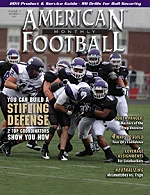Article CategoriesAFM Magazine
|
Linebacker Play – Knowing Your Assignment Pre-Snapby: Terrol DillonLinebackers and Special Teams Coach, Texas State University © More from this issue At Texas State, in order to execute zone coverage against the pass, it is critical Today, the spread offense and passing game have become very prevalent. As LBs, we are run defenders first. However, more often than not, we will find ourselves defending the pass more than the run throughout the course of a game. At Texas State, our dilemma has become teaching our LBs how to stay fast and aggressive to the run and, at the same time, sound and effective against the passing game. We have adopted what we feel to be a very simple philosophy to get this accomplished. We are primarily a zone team, and regardless of the zone coverage that is called, our technique stays the same. We use the same key phrases and terms to describe our ....The full article can only be seen by subscribers.
|
|
|||||||
| HOME |
MAGAZINE |
SUBSCRIBE | ONLINE COLUMNISTS | COACHING VIDEOS |
Copyright 2025, AmericanFootballMonthly.com
All Rights Reserved





